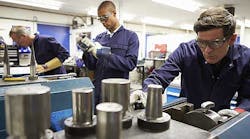Applying Lean Manufacturing Principles to Job Training
You’re probably familiar with the principles of lean manufacturing. Stripped to its roots, lean focuses on decreasing waste, increasing value to the customer and a process of continuous improvement.
Lean has been around for some time -- you might date its origins back to Deming, Ford or -- most commonly -- to the Toyota Production System (TPS) developed in the late 1940s. Manufacturers and other companies throughout the world have had time to study and implement the lessons of TPS since then, and there are many success stories as a result.
Yet, many of the same people who see the value of lean, and who have successfully implemented it into their workplaces, don’t recognize how those same principles can apply to their training programs. In fact, they often violate the fundamental rules of lean, intentionally adding waste and overburdening their trainees. And, as a result, they wind up delivering less value to their customers -- their trainees and/or their employers -- than they would with a training approach that borrows from lean.
Let’s take a look at how people learn and then see how some basic lean approaches can be applied to training.
How People Learn
Learning and development experts, using research from cognitive psychology, believe that the process of learning and remembering can be broken down into four basic stages:
- Sensory memory
- Working memory
- Long-term memory
- Transfer to the job
Let’s look at each to see what they mean. Because it’s essentially a linear process, somewhat like a manufacturing line, you’ll see how the lean concept of flow applies. Your job as a trainer is to aid flow, just as that’s your job in production.
Sensory Memory
Your sensory memory actively processes all the sensory stimuli in the world around you during training. This includes the temperature in the room, any noises, the view out the window, the actual training materials -- everything.
Most of this information is filtered out automatically by the brain -- you’re not actively aware of it. The stuff that doesn’t get filtered out automatically moves on to the next stage.
Working Memory
Your working memory is the stuff you’re actively processing or “working on” in your brain. The hitch is that the brain can only process and hold a small amount of information in the working memory. Traditionally, this estimate has been “seven, plus or minus two” bits of information, but more recently, the estimate has been scaled down to around four bits.
The information in working memory ends up either being stored in your long-term memory (the next phase we’ll talk about) or being simply forgotten and vanishing forever.
Long-term Memory
Some of the information processed by the working memory gets stored in your long-term memory (the rest is simply lost, remember). The new information in the long-term memory gets stored in little “packets” of related information called schemas. It appears as if the long-term memory has an unlimited capacity and that once information is there, it’s there forever.
Transfer of Knowledge and Skills to the Job
Finally, your workers will take the information stored in their long-term memory and apply it on the job. This is called transfer. Having the information stored in the long-term memory isn’t a guarantee that your worker will transfer it and apply it on the job, however. Sometimes the brain can’t find the stored information, and other times the worker isn’t motivated to apply it.
Applying Lean Principles to the Four Stages of Learning for More Effective Training
Now let’s turn our attention to training.
We’ll start by considering the lean goal of increasing value to the customer. In this case, our customer is either our trainee(s), the company that employees the trainee(s) or both. And the value they’re looking for is more effective training -- training that leads to having the worker apply the desired knowledge and skills in the workplace. Keep that in mind as you read this guide and as you create and deliver your own training materials -- always keep the needs of the trainee first and foremost.
With that point in mind, let’s see how we could apply some lean thinking in each of the four steps of learning and applying information to make our training more effective.
Lean Training Techniques for the Sensory Memory
Remember that the sensory memory is processing all the sensory stimuli going on during training, and that most of this is automatically filtered out by the brain in a pre-conscious manner. Your goal is to make sure the brain isn’t automatically filtering out the stuff you want your employees to learn.
And so lean’s focus on preventing waste begins right here. A good trainer can help the trainee by removing distractions from the room -- uncomfortable temperatures, irritating noises, slow computers and similar things that are likely to “stick” in the learner’s brain.
The trainer can also improving the training by including things that draw the trainee’s pre-conscious attention to the important aspects of the training materials. This can include things like arrows, circles and highlights in key points within a visual, for example.
Lean Training Techniques for the Working Memory
As you recall, the working memory is where your brain actively processes new information. You’ll also recall it can process only a very limited amount of information.
To create better training materials with the working memory in mind, follow these tips:
A. Create a set of “learning objectives” and only include training materials that support those objectives. A learning objective is something you want you want employees to be able to do when the training is over. Always begin the process of creating training by creating learning objectives. Then create training materials (and tests) that support those objectives, being careful to eliminate all the “waste” of unnecessary material you may want to add.
B. Break your training down into small “chunks” and organize those chunks in a way that helps your employees learn. To avoid overwhelming your workers, break your training down into small chunks of information. This helps them process the information without getting overwhelmed and losing it all.
Next, organize those chunks in a manner that helps your workers build up the smaller pieces into an organized whole.
You can even diagram your chunks during the planning phase in a way that’s similar to value process mapping.
Remember your limit is about four pieces of new information -- then work in some practice to reinforce the information, or a break, or both.
C. Keep it simple and short. If your goal is to avoid overwhelming your workers, it’s important to cut your training to the bone. Include the important stuff, but nothing more. Remember, you’re trying to build a lean training program.
D. Keep the training active. The more your workers actively participate, the less likely they will be to tune out. Active training participation is one of several adult learning principles that will keep your workers more engaged.
E. Provide job aids when it’s not necessary to memorize things. Take a look at your training materials and see if it’s really necessary for workers to memorize all of it. If you can reduce the amount of pure memorization by providing them a job aid they can refer to on the job, do it.
Lean Training Techniques for the Long-term Memory
When information is moved from the working memory and stored in the long-term memory, it’s stored in little “packets” of related information called schemas.
As a result, it’s helpful to introduce new information by relating it to information your workers already know. Things like comparisons, similes and metaphors are very good at helping workers take new information and relate it to things they already know -- and, as a result, store the new information in existing schemas.
You may be thinking that we’ve been focusing on removing things from training and stripping it to the bone, and that here we’re talking about adding something. That’s true, but we’re talking about adding something that provides value to our “customer” by making it easier to learn something, so we’re not violating a lean principle (nor are we violating the guidelines for creating effective training).
Lean Training Techniques for Transfer to the Job
And now we’re at the final stage -- transferring information from training and applying it on the job.
To help workers apply the knowledge and skills from training on the job, consider doing the following during training (all of which add value):
A. Start your training by explaining to your workers how it will benefit them. This is the classic “what’s in it for me?” aspect of training delivery.
B. Provide lots of hands-on exercises that let your workers practice the skills they’re supposed to perform on the job. Actually performing the skill during training will make it much more likely the workers will be able to do it on the job, too.
C. Provide training in the real work environment. People are more likely to apply things they learned in training if they learned it in the same environment in which they’ll later be expected to use it. Given that, deliver training in the work area when it’s possible.
D. Provide realistic simulations in training when possible. Let workers practice their new skills in realistic, scenario-based training when possible. For example, let a new sales person practice applying sales techniques to “simulated” customers asking realistic sales-related questions.
E. Test workers at the end of training to see if they can satisfy the learning objectives. If you test your workers after training and they can satisfy the learning objectives, they’re good to go. If not, you know you need to give them some additional feedback, help, and practice.
Training, Evaluation and Continuous Improvement
It wouldn’t be a full comparison of lean manufacturing and job training if we didn’t touch on continuous improvement. Continuous improvement is a hallmark of lean manufacturing and goes hand-in-hand with reducing waste and increasing value. Likewise, you should aim to continuously improve your training program as well. Why settle for how things are now when they can be better?
In lean manufacturing, a key aspect of continuous improvement is measuring your key performance indicators (KPIs) and seeing if your improvement efforts are having a real effect on production, waste, quality and value.
In the same way, you should gather data about the effectiveness of your training program too. The goal, obviously, is to see if the changes you make over time create more effective training materials. The effectiveness of training is traditionally measured in four different levels:
1. Trainee reaction -- measured with post-training survey sheets
2. Trainee learning -- measured with post-training tests
3. Training job performance -- gathered through on-the-job observations before and after training
4. Business goals -- measured through business KPIs and analyzed to see if training is having a desired positive effect
Setting up methods to gather this data, keeping it over time and comparing your trends is a great way to see if your training program is truly continuously improving.
The Takeaway: Leaner Training = More Effective Training
As you see, the three fundamental principles of lean manufacturing -- reducing waste, increasing value, and continuous improvement -- relate very directly to training as well. But for whatever reason, even the savviest experts in lean manufacturing sometimes don’t see how the same principles apply in training.
If you implement some of the tips above in your own training program, you’ll find the same positive benefits you noticed when you first implemented lean. And, in the same way, you’ll begin a never-ending process of continual improvement.
Jeff has worked in training and student education for 25 years. In his current position at Convergence Training, a provider of training solutions for manufacturing industries, Jeff acts as a consultant to help customers design and implement training solutions for their workers, including both job-specific and safety/EHS training.





